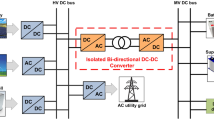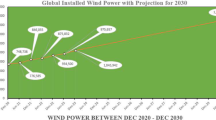Abstract
In this paper, steady-state operating conditions of a doubly fed induction generator (DFIG) are computed considering losses of grid-side (GS) filter. Two different cases are studied for steady-state initialization of the DFIG-based wind turbine systems (WTS). In the first case, active power (P) and reactive power (Q) at DFIG terminals are assumed to be known. In the other case wind speed (\(V_{w}\)), Q is assumed to be known. Apart from considering losses of the DFIG and GS filter, both the cases also consider the non-unity power factor operation of the grid side converter (GSC). For the first case, steady-state operating conditions are calculated by iterative method as well as by non-iterative method. For the second case, iterative method is used to calculate steady-state operating conditions. Calculation of steady-state values of other subsystems of DFIG-based WTS like drive train, controller and network is also shown. The initial values calculated are validated and compared by performing modal analysis and time-domain simulations.













Similar content being viewed by others

Data availability
Not applicable.
References
Abad G, Lopez J, Rodríguez M, Marroyo L, Iwanski G (2011) Introduction to a wind energy generation system
Fan L, Miao Z (2015) Modeling and analysis of doubly fed induction generator wind energy systems. Academic Press, Cambridge
Gianto R (2021) Steady-state model of DFIG-based wind power plant for load flow analysis. IET Renew Power Gener 15(8):1724–1735
Amutha N, Kumar BK (2014) Initialization of DFIG based wind generating system. In: 2014 eighteenth national power systems conference (NPSC). IEEE, pp 1–5
Padrón JFM, Lorenzo AEF (2009) Calculating steady-state operating conditions for doubly-fed induction generator wind turbines. IEEE Trans. Power Syst. 25(2):922–928
Karthik DR, Kotian SM, Manjarekar NS (2021) Steady-state initialization of doubly fed induction generator based wind turbine considering grid side filter. In: 2021 13th IEEE PES Asia pacific power energy engineering conference (APPEEC). IEEE, pp 1–6
Kumar Seshadri Sravan V, Thukaram D (2018) Accurate modeling of doubly fed induction generator based wind farms in load flow analysis. Electr Power Syst Res 155:363–71
Ledesma P, Usaola J (2005) Doubly fed induction generator model for transient stability analysis. IEEE Trans Energy Convers 20(2):388–397
Karthik DR, Kotian SM, Manjarekar NS (2022) An accurate method for steady state initialization of doubly fed induction generator. In: 2022 IEEE international conference on power electronics, smart grid, and renewable energy (PESGRE). IEEE, pp 1–6
Slootweg JG, Polinder H, Kling WL (2001) Initialization of wind turbine models in power system dynamics simulations. In: 2001 IEEE Porto power tech proceedings (Cat. No. 01EX502), Vol 4. IEEE, pp 6
Holdsworth L, Wu XG, Ekanayake JB, Jenkins N (2003) Direct solution method for initialising doubly-fed induction wind turbines in power system dynamic models. IEE Proc Gener Transm Distrib 150(3):334–342
Wu M, Xie L (2017) Calculating steady-state operating conditions for DFIG-based wind turbines. IEEE Trans Sustain Energy 9(1):293–301
Alejandro Joaquín P (2019) Initialization of DFIG wind turbines with a phasor-based approach. Wind Energy 22(3):420–32
Louie KW, Wang A, Wilson P, Buchanan P (2005) Discussion on the initialization of the EMTP-type programs. In: Canadian conference on electrical and computer engineering, pp 1962–1965. IEEE
Feijoo A, Villanueva D (2016) A PQ model for asynchronous machines based on rotor voltage calculation. IEEE Trans Energy Convers 31(2):813–814
Eminoglu U, Dursun B, Hocaoglu MH (2009) Incorporation of a new wind turbine generating system model into distribution systems load flow analysis. Wind Energy Int J Progress Appl Wind Power Convers Technol 12(4):375–390
Feijóo A (2009) On PQ models for asynchronous wind turbines. IEEE Trans Power Syst 24(4):1890–1891
Huang C (2018) Two RX models of doubly-fed induction generators for load flow analysis. In: 2018 2nd IEEE conference on energy internet and energy system integration (EI2). IEEE, pp 1–6
Muller S, Deicke M, De Doncker RW (2002) Doubly fed induction generator systems for wind turbines. IEEE Ind Appl Mag 8(3):26–33
de Wekken TV, Wein F Power quality and utilization guide section-8. In: KEMA consulting Distributed generation Leonard Energy Autumn
Manwell JF, McGowan JG, Rogers AL (2010) Wind energy explained: theory, design and application. Wiley, New York
Ekanayake JB, Holdsworth L, Wu X, Jenkins N (2003) Dynamic modeling of doubly fed induction generator wind turbines. IEEE Trans Power Syst 18(2):803–809
Padiyar KR (2006) Power system dynamics—stability and control. BS Publications, Hyderabad
Fan L, Kavasseri R, Miao ZL, Zhu C (2010) Modeling of DFIG-based wind farms for SSR analysis. IEEE Trans Power Deliv 25(4):2073–2082
Prasanthi E, Shubhanga KN (2016) Stability analysis of a grid connected DFIG based WECS with two-mass shaft modeling. In: 2016 IEEE annual India conference (INDICON). IEEE, pp 1–6
Fan L, Zhu C, Miao Z, Hu M (2011) Modal analysis of a DFIG-based wind farm interfaced with a series compensated network. IEEE Trans Energy Convers 26(4):1010–1020
Funding
Not applicable.
Author information
Authors and Affiliations
Contributions
DRK was involved in conceptualization, methodology, software, formal analysis, investigation, writing — original draft. NSM and SMK contributed to supervision, writing—review & editing, resources.
Corresponding author
Ethics declarations
Conflict of interest
The authors declare no competing interests.
Ethical approval
Not applicable.
Additional information
Publisher's Note
Springer Nature remains neutral with regard to jurisdictional claims in published maps and institutional affiliations.
Appendices
Appendices
1.1 Appendix A
In this appendix following parameters of WTS are listed as given in Ref. [10]
\(C_p\) = \(c_1(\frac{c_2}{\lambda _i}-c_3\beta -c_4)e^{\frac{-c_5}{\lambda _i}}\), \(\frac{1}{\lambda _i}=\frac{1}{\lambda +0.08\beta }-\frac{0.035}{\beta ^3+1}\)
where \(\lambda \) is tip-speed ratio given by \(\lambda \)=\(\frac{\omega _{rtm}R}{V_w}\), \(\beta \) = pitch angle. \(c_1\)=0.22, \(c_2\)=116, \(c_3\)=0.4, \(c_4\)=5, \(c_5\)=21.
The value of \(k_\textrm{opt}\) is calculated by, \(k_\textrm{opt}=\frac{1}{2}\frac{\rho A C_{p_\textrm{opt}} R^3\omega _{rtmB}^3}{s_B \lambda _\textrm{opt}^3}=0.67031\) pu, where R = Rotor radius, \(\omega _{rtmB}\) = Nominal speed of turbine, \(s_B\) = Base MVA.
when, \(\beta \) = \(0^o\), we have \(\lambda _\textrm{opt}\) = 8.1001, and the corresponding \(C_{p_\textrm{opt}}\) = 0.48.
The considered parameters of GS filter are \(L_g\) = 0.0225 pu, \(R_g\) = 0.012 pu
parameters of DC link capacitors are C = 0.014 F, \(v_{\textrm{d}c}\) = 1200 V
Formula used for fixed point iteration method is \(\vec V_{{s(k+1)}} = \vec {V_1} + (\frac{P+jQ}{\vec {V_{s(k)}}})^*Z_l\).
Transmission line resistance (\(R_l\)) is 0.002 pu. Transmission line reactance (\(X_l\)) (including transformer reactance (\(X_{tr}\))) is 0.02 pu
1.2 Appendix B
Rights and permissions
Springer Nature or its licensor (e.g. a society or other partner) holds exclusive rights to this article under a publishing agreement with the author(s) or other rightsholder(s); author self-archiving of the accepted manuscript version of this article is solely governed by the terms of such publishing agreement and applicable law.
About this article
Cite this article
Karthik, D.R., Manjarekar, N.S. & Kotian, S.M. Computation of steady-state operating conditions of a DFIG-based wind energy conversion system considering losses. Electr Eng 105, 1825–1838 (2023). https://doi.org/10.1007/s00202-023-01766-x
Received:
Accepted:
Published:
Issue Date:
DOI: https://doi.org/10.1007/s00202-023-01766-x



